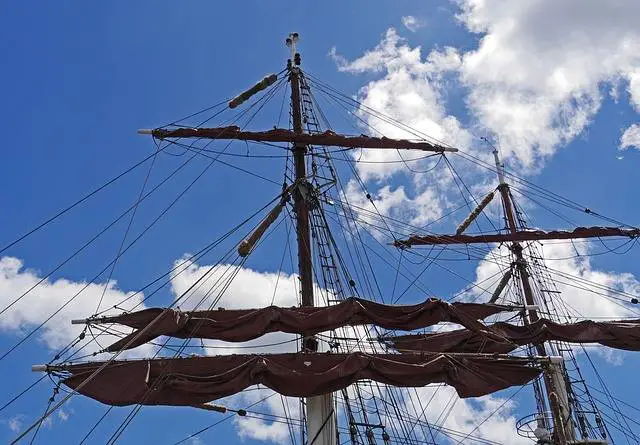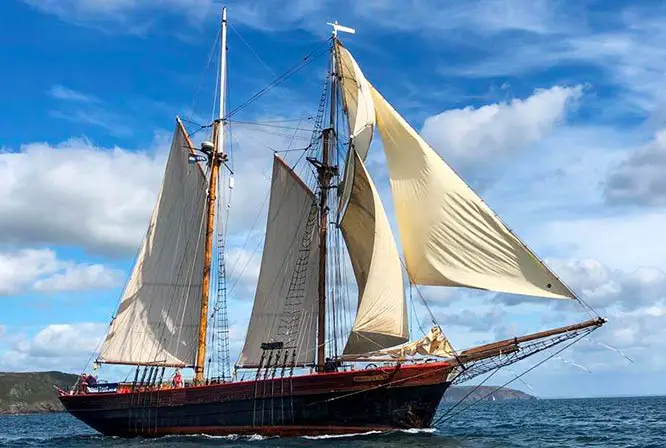A tall ship is a magnificent sailing vessel that has stood the test of time, connecting the past with the present in a unique way. These ships range from 30 to 200 feet tall, and their sails and rigging are true works of art.
Tall ships are often used for training, education, and recreation purposes, as well as for historical and cultural events. They can also be seen as symbols of adventure, exploration, and maritime heritage.
While many people appreciate the beauty of a tall ship, few understand the complex hierarchy and roles that make them function as they do.
How do the crew members work together to operate such a complex and majestic vessel? In this article, we will explore the main positions and responsibilities on board a tall ship, as well as the structure and organization of the crew.
The Captain
The captain is the highest-ranking officer and the ultimate authority on a tall ship. He or she is responsible for the safety, navigation, and overall management of the vessel and its crew. The captain has the final say in all decisions regarding the ship’s operations, such as setting the course, choosing the sails, handling emergencies, and dealing with external parties.
The captain also has a duty to ensure that the ship’s mission and objectives are fulfilled, whether they are educational, recreational, or historical. The captain must also maintain good communication and rapport with the crew, the passengers (if any), and the shore-based organization that owns or operates the ship.
The captain usually has a lot of experience and qualifications in sailing and maritime affairs. He or she may also have a background in education, leadership, or management. The captain may be assisted by one or more mates or officers who share some of his or her duties and report directly to him or her.
The mates
The mates are the second-in-command on a tall ship. They are senior officers who assist the captain in running the ship and supervising the crew. Depending on the size and type of the vessel, there may be one or more mates on board, such as first mate, second mate, third mate, etc.
The mates are usually in charge of specific areas or functions on the ship, such as navigation, engineering, deck operations, safety, maintenance, etc. They also act as watch leaders who rotate shifts with other mates to keep an eye on the ship’s condition and performance at all times.
The mates are responsible for giving orders and instructions to the crew members under their watch. They also train and mentor the crew members in various skills and tasks related to sailing and seamanship. The mates must ensure that the crew follows the captain’s orders and adheres to the ship’s rules and regulations.
The mates usually have a lot of experience and qualifications in sailing and maritime affairs. They may also have a background in education, leadership, or management. The mates report directly to the captain and may take over his or her role in case of absence or incapacity.
The Officers
The officers on a tall ship fall under the captain’s command and are responsible for ensuring the smooth operation of the vessel.
They are in charge of specific areas of the ship, and their role is to direct the crew members under their command. They must be knowledgeable in the areas of navigation, engineering, and communications.
They must also dock the ship when necessary and make sure the crew is performing their duties safely and efficiently. The officers on a tall ship are expected to lead by example, always maintaining professionalism and setting an excellent example for the crew.
The Crew
The crew on a tall ship is divided into three categories: the deck crew, the galley crew, and the engineering crew.
The Deck Crew
The deck crew is responsible for maintaining the ship’s exterior. They are in charge of the sails, rigging, and the hull. They must be proficient in knot tying, sail handling, and splicing ropes.
The Galley Crew
The galley crew is in charge of the ship’s kitchen and dining areas. They must be skilled in food preparation, cooking, and food storage. They are responsible for preparing meals for the crew and passengers, keeping the ship’s kitchen clean and well-maintained, and ensuring that food is stored correctly.
The Engineering Crew
The engineering crew is responsible for the ship’s mechanical systems, such as propulsion, electrical systems, and plumbing. They must be knowledgeable in these areas and able to make repairs and keep the systems in good working order. They are also responsible for maintaining the ship’s cleaning and sanitation systems.
Each member of the crew plays an important role in the operation of a tall ship. Cooperation and communication are key to the success of the ship and the safety of everyone on board.
The doctor
The doctor is responsible for providing medical care for the crew and passengers (if any). He or she also ensures that there is enough medicine, equipment, and supplies for the ship’s needs. The doctor may be assisted by one or more nurses who help him or her in these tasks.
Conclusion
A tall ship is a fascinating and complex vessel that requires a lot of skill, knowledge, and teamwork to operate. There are different roles and hierarchies on a tall ship that reflect its functions and objectives. Each position has its own responsibilities and challenges that contribute to making sailing a tall ship an unforgettable experience.
We hope you enjoyed this article about the different roles and hierarchies on a tall ship. If you want to learn more about sailing and seamanship, or if you want to join us on one of our voyages aboard our beautiful tall ships,
please visit our website at tallshipssunderland.com.
We look forward to hearing from you soon! ⛵️

![How to Train to Become a Tall Ship Sailor [6 Steps] How to Train to Become a Tall Ship Sailor [6 Steps]](https://www.tallshipssunderland.com/wp-content/uploads/2023/03/tall-ship-sailor-150x150.jpg)
![The Importance of Safety Measures on Tall Ships [Video] The Importance of Safety Measures on Tall Ships [Video]](https://www.tallshipssunderland.com/wp-content/uploads/2023/03/tall-ship-safety-150x150.jpg)



![The Challenges of Living on a Tall Ship [The Ultimate Adventure] The Challenges of Living on a Tall Ship [The Ultimate Adventure]](https://www.tallshipssunderland.com/wp-content/uploads/2023/03/tall-ship-challenges-150x150.jpg)